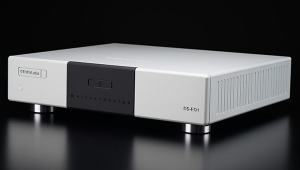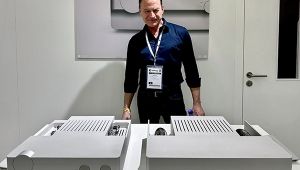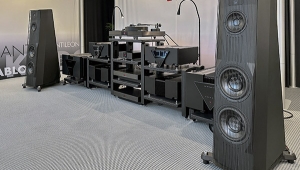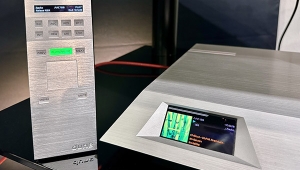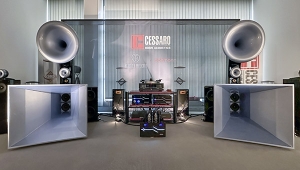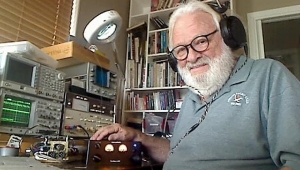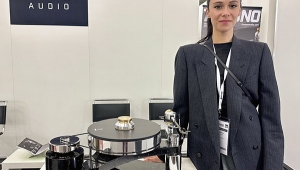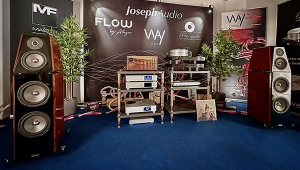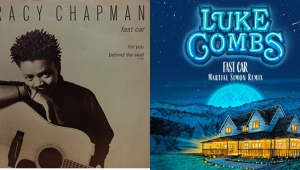| Columns Retired Columns & Blogs |
Spin Doctor #10: Tone Controls, Vinyl EQ Curves, and the Mola Mola Lupe Page 2

Typically, moving magnet inputs are comparatively simple, with fixed gain, a fixed 47k ohm load, and perhaps, on the fancier ones, a capacitive loading option. Japanese manufacturers have traditionally taken moving magnet cartridges more seriously, offering a wider range of moving magnet input options. For example, the Luxman EQ-500, reviewed by Art Dudley in 2016, has just two settings for the moving coil input but a host of adjustments for moving magnet cartridges. The Lupe follows this lead, with five moving magnet resistance loads, from 18k ohms to 120k ohms, eight capacitive loads, from 0pF to 380pF, and two gain settings, at 45dB and 50dB. This final setting is the only place where I can foresee a cartridge compatibility issue, specifically with low-output induced-magnet cartridges like some of the better Grado and especially Soundsmith models. These cartridges require a load resistance close to 47k ohms, but their low output—as low as 0.4mV with some Soundsmith models—requires more than 50dB of gain. If you're thinking that you could simply use the higher gain moving coil input instead—well you could, but you'd run into a loading problem, with the 1k ohm maximum resistive load setting over on the moving coil side.
To explore this issue, I tried using the Lupe with my 1mV–output Grado Epoch cartridge through the moving magnet input, set to 50dB gain, and found that it was fine, with sufficient gain and very low noise. Still, I'm less confident that Soundsmith cartridges with even lower output would work as well. These are very isolated examples. With 99% of cartridges, the Lupe's adjustments will cover all bases.
Moving on: Additional controls on each preset include a mono switch, a subsonic filter, and the ability to invert the polarity of each channel. That last setting is useful when playing vertically cut records, such as Edison Diamond Discs or transcription records. Hopefully I can keep the Lupe around long enough to try this with some of the transcription records I have with Stan Maxwell's Gates turntable.
Finally, the Lupe's main party trick, which some have referred to as its 72 phono equalization curves. That's actually a bit disingenuous, because probably there haven't been 72 different EQ curves used in the history of records. What the Lupe offers is 72 possible permutations of its three basic EQ variables, bass turnover, rolloff, and low shelf. You can set each of these variables individually and save them to the Custom preset, but what makes the Lupe especially user-friendly is its preprogrammed settings, listed by record label. If you're playing an early mono LP or 78, you can pick the preset by the label, and in some cases by year, without having to look up the settings on a chart and adjust them manually.
Forty-three labels are listed in addition to the Custom and RIAA, but a bunch of notable labels are missing from the list, such as Blue Note, Deutsche Grammophon, and Teldec (footnote 3). The app allows you to update the Lupe's control firmware wirelessly, so hopefully Mola Mola will expand the record label list over time.
One odd little anomaly I spotted is that the RIAA preset's bass turnover is displayed as 315µs, rather than the correct 318µs. That difference would shift the frequency up from the nominal 500Hz to about 505Hz, admittedly a pretty insignificant difference. Perhaps it's just a typo.
One fear I have is that all these adjustments and features will distract people from the Lupe's main plus point: its extraordinary performance. Because this phono stage really made my records sing!

I was born a couple of years into the stereo LP era; I must confess that my record collection does not include an extensive selection of early mono pressings. I do have plenty of mono records, but most of them are from the late 1950s or reissues cut well after RIAA was established. I do however have a first pressing of RCA LM-1086, Brahms's 4th Symphony, with the venerable Boston Symphony Orchestra conducted by Charles Munch. This April 1950 recording was made with the legendary RCA recording team of producer Richard Mohr and recording engineer Lewis Layton, about five years before they started working in stereo to create many of the best regarded RCA Living Stereo releases. 1950 was also a couple of years before RCA was using the New Orthophonic curve, so the Lupe's app told me to use their early-RCA preset. Playing the record on the SME 30/2 with the Korf tonearm and Miyajima Kotetu mono cartridge, I was able to switch easily between the early RCA curve and RIAA, focusing in on the differences. But the first thing I noticed was just how clean this not-quite-three-quarters-of-a-century-old record sounded. The surfaces were smooth and quiet, and the tracking was superb, with no breakup or distortion.
Tonally, I heard two key differences between the RIAA and RCA curves. With the latter, the bottom end was leaner and tighter and the midrange opened up. With RIAA, the midrange sounded a bit more closed in and boxy and a bit thick at times.
After switching over to the Aidas Malachite Green on the SME + Korf, I played "Hey You" from my first UK pressing of Pink Floyd's The Wall (Harvest SHDW 411). Here, the Lupe's exceptional dynamic grip on the music, as the song ebbed and flowed, is what first caught my ear, underpinned by the fretless bass glisses, played by Dave Gilmour instead of Roger Waters, the regular PF bassist. The soundstage focus and dimensionality were equally impressive, allowing you to listen into and around each element within the image. On the folloing track, "Is There Anybody Out There?," the texture and body of session musician Joe DiBlasi's plucked classical guitar came across beautifully, all the subtle details of his playing presented with clarity.

The human voice was also well served by the Lupe. When I played "I Could Write a Book" from Johnny Hartman's album Once in Every Life (Bee Hive BH 7012), I was able to bask in the rich glow of Hartman's deep baritone. I have been using this record to evaluate equipment for over 35 years, and I can't recall any phono stage that extracted more music from it than the Lupe. In some systems, the sound of this record can edge toward brightness and sibilance, but with the Lupe, everything was impressively resolved and clean.
This is not a warm, fuzzy-sounding phono stage, but it is exceptional in its ability to take all the information a cartridge throws at it and sort it into a sound that's coherent and detailed, and it never sounds bright or hard. "Resolving" is the word that keeps popping into my head. When it comes to sorting out recordings, the Lupe can out-resolve just about anything I've heard.
At $9850, its price is high, but the Lupe delivers performance that matches up well with even more costly alternatives. The versatility it offers is unmatched, making it a real Swiss Army knife for phono replay. For the serious vinyl archivist with several turntables, arms, and cartridges, I can think of no other phono preamp that offers this level of versatility. Even the extraordinary CH Precision P1, at more than three times the Lupe's price, can't quite match the flexibility you get here.
All the bells and whistles aside, I was mostly impressed by the Lupe's ability to breathe fresh life into pretty much every record I played through it.
Footnote 3: DG and Teldec were both major players in the EQ-curve game.
- Log in or register to post comments
